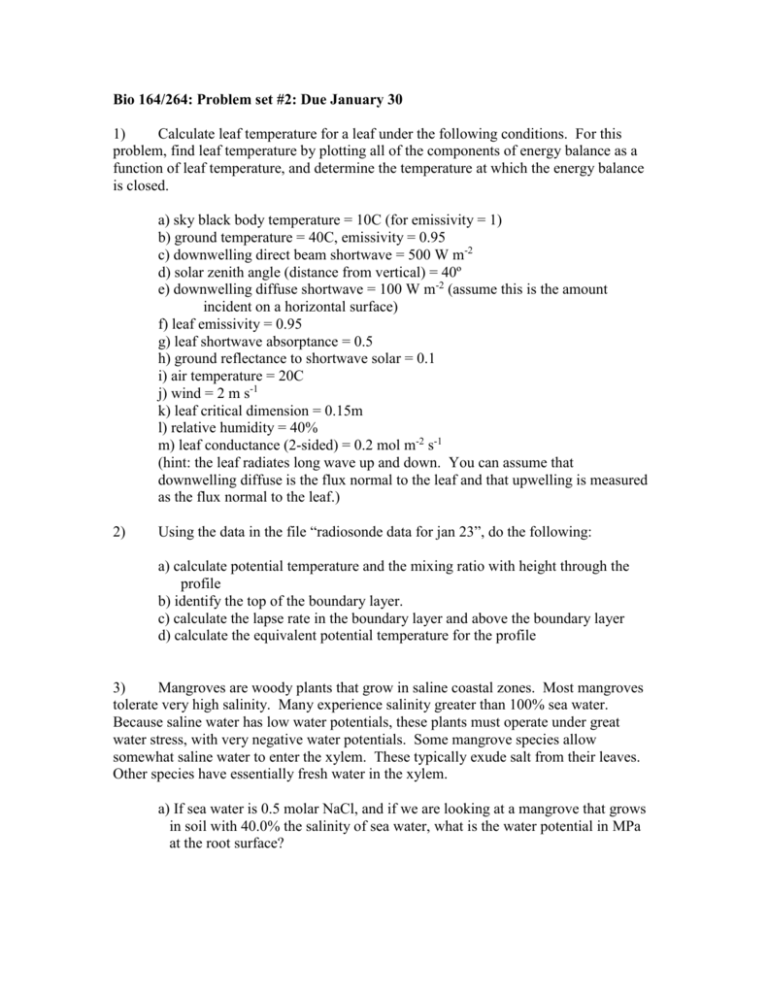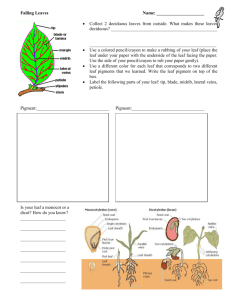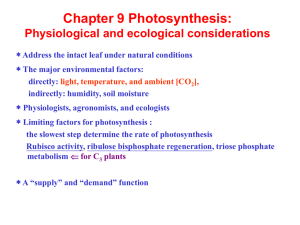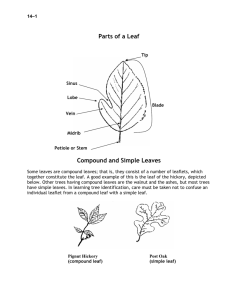Bio 164/264: Problem set #1: Due January 23
advertisement

Bio 164/264: Problem set #2: Due January 30 1) Calculate leaf temperature for a leaf under the following conditions. For this problem, find leaf temperature by plotting all of the components of energy balance as a function of leaf temperature, and determine the temperature at which the energy balance is closed. a) sky black body temperature = 10C (for emissivity = 1) b) ground temperature = 40C, emissivity = 0.95 c) downwelling direct beam shortwave = 500 W m-2 d) solar zenith angle (distance from vertical) = 40º e) downwelling diffuse shortwave = 100 W m-2 (assume this is the amount incident on a horizontal surface) f) leaf emissivity = 0.95 g) leaf shortwave absorptance = 0.5 h) ground reflectance to shortwave solar = 0.1 i) air temperature = 20C j) wind = 2 m s-1 k) leaf critical dimension = 0.15m l) relative humidity = 40% m) leaf conductance (2-sided) = 0.2 mol m-2 s-1 (hint: the leaf radiates long wave up and down. You can assume that downwelling diffuse is the flux normal to the leaf and that upwelling is measured as the flux normal to the leaf.) 2) Using the data in the file “radiosonde data for jan 23”, do the following: a) calculate potential temperature and the mixing ratio with height through the profile b) identify the top of the boundary layer. c) calculate the lapse rate in the boundary layer and above the boundary layer d) calculate the equivalent potential temperature for the profile 3) Mangroves are woody plants that grow in saline coastal zones. Most mangroves tolerate very high salinity. Many experience salinity greater than 100% sea water. Because saline water has low water potentials, these plants must operate under great water stress, with very negative water potentials. Some mangrove species allow somewhat saline water to enter the xylem. These typically exude salt from their leaves. Other species have essentially fresh water in the xylem. a) If sea water is 0.5 molar NaCl, and if we are looking at a mangrove that grows in soil with 40.0% the salinity of sea water, what is the water potential in MPa at the root surface? b) If the transpiration rate at midday is 3 mmol m-2 s-1 and if the bulk hydraulic conductance is 15 mmol m-2 s-1 MPa-1, then what is the midday leaf water potential? c) If the mesophyll cells have a midday turgor pressure of 0.5 MPa, what is their midday osmotic potential? What is the solute concentration required to produce this osmotic potential? Useful stuff: For this calculation, you can assume the plant height is negligible. NaCl completely dissociates, so the osmotic effect is that of the two ions (the osmotic coefficient = 1 and the number of ions = 2). The temperature of the leaf is 25C or 298.16K. To convert the initial answer in J l-1 to MPa, you need to convert J l-1 to J m-3 and then note that 1 J m-3 = 1 n m-2 = 1 Pa In midday, the leaves will have water potentials more negative than those in the soil by the amount of the soil to leaf pressure gradient The bulk hydraulic conductance is the proportionality factor between the flux and the pressure gradient. E = gxb*P or P = E/gxb










